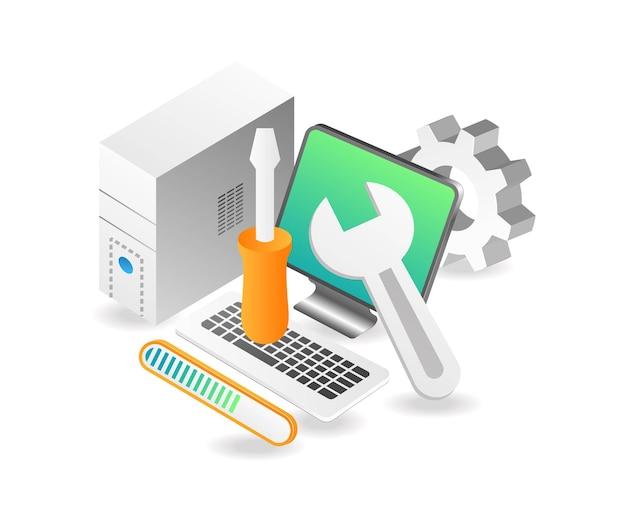In today’s fast-paced world, businesses rely heavily on technology and machinery to keep their operations running smoothly. However, as these systems continue to evolve, ensuring their proper functioning becomes increasingly complex. That’s where maintenance data comes in. By properly managing and analyzing maintenance datasets, businesses can optimize their maintenance operations, minimize downtime, and increase overall productivity. In this blog post, we will explore what maintenance data is, its importance, and the process of data maintenance. So let’s dive in and discover the key to keeping your systems in top shape!
Maintenance Data: Keeping Your Equipment in Top Shape
Introduction
Gaining insights from your maintenance data can make a world of difference in keeping your equipment running smoothly. By analyzing and utilizing this valuable information, you can improve efficiency, reduce costs, extend equipment lifespan, and even prevent breakdowns. In this article, we will explore the importance of maintenance data and how you can harness its power to optimize your operations.
Unveiling the Hidden Gem
Maintenance data is like a treasure chest overflowing with valuable information. It provides an in-depth overview of your equipment’s health, usage patterns, and potential issues. By delving into this data, you can uncover hidden trends, identify recurring problems, and make data-driven decisions to enhance your maintenance strategies.
Key Metrics that Matter
When it comes to maintenance data, certain key metrics take center stage and steal the spotlight. Let’s take a closer look at some of these metrics that can help you maximize your operational efficiency:
1. Mean Time Between Failures (MTBF)
MTBF measures the average time a piece of equipment operates before encountering a failure. By tracking this metric, you can spot trends and predict potential breakdowns, allowing you to take proactive measures and reduce costly downtime.
2. Mean Time to Repair (MTTR)
MTTR quantifies the average time it takes to repair a piece of equipment after a failure occurs. Analyzing MTTR can help you pinpoint bottlenecks in your repair processes and devise strategies to minimize downtime, ultimately boosting your overall productivity.
3. Failure Patterns
Examining failure patterns enables you to identify common issues and their causes. With this knowledge, you can implement targeted preventive maintenance measures and significantly reduce the occurrence of equipment failures.
The Power of Predictive Maintenance
Maintenance data paves the way for predictive maintenance, a game-changing strategy that moves away from reactive approaches. By analyzing historical data, monitoring real-time metrics, and utilizing sophisticated algorithms, predictive maintenance can forecast potential failures, allowing you to take action before they happen.
Predictive maintenance empowers you to avoid unplanned downtime, optimize resource allocation, extend equipment lifespan, and streamline maintenance schedules. It’s like having a crystal ball that reveals the future and helps you stay one step ahead.
Making Maintenance Data Work for You
To fully harness the power of maintenance data, you need to implement a comprehensive data management system. This includes collecting accurate and relevant data, establishing clear data collection procedures, using specialized maintenance software, and training your staff to make data-driven decisions.
Remember, maintenance data is not just a bunch of numbers on a spreadsheet; it’s the secret ingredient that can transform your operations from good to exceptional. So, embrace the power of maintenance data and unleash the full potential of your equipment!
Maintenance data holds the key to optimizing your equipment, reducing costs, and preventing breakdowns. By analyzing key metrics, embracing predictive maintenance, and implementing effective data management strategies, you can revolutionize your maintenance practices and take your operations to new heights. So, dive deep into your maintenance data treasure chest, discover precious insights, and let your equipment shine!
Maintenance Dataset
Introduction
In the digital age, data holds immense value, and maintenance is no exception. A maintenance dataset serves as a treasure trove of essential information that can revolutionize the way we approach upkeep and repairs. By analyzing this dataset, we can unlock actionable insights, optimize workflows, and ensure optimal equipment performance. In this subsection, we delve into the significance and benefits of a maintenance dataset.
Unleashing the Power of Data
A maintenance dataset comprises a collection of records that document various aspects of maintenance activities. From equipment downtime and repair history to inventory management and resource allocation, this dataset captures invaluable details. With access to such data, facilities can gain a comprehensive understanding of their maintenance operations, identify patterns, and make informed decisions.
Predictive Maintenance at its Finest
One of the key advantages of a maintenance dataset is its ability to enable predictive maintenance strategies. By leveraging historical data, patterns, and machine learning algorithms, facilities can anticipate and prevent potential equipment failures. This proactive approach minimizes downtime, avoids costly repairs, and enhances overall operational efficiency.
Efficient Resource Allocation
With a maintenance dataset at your fingertips, strategically allocating resources becomes a breeze. By analyzing past patterns, facilities can identify which equipment requires the most attention, prioritize maintenance tasks, and optimize scheduling. This ensures that resources are utilized effectively, reducing unnecessary expenses and improving operational outcomes.
Continuous Improvement and Optimization
A maintenance dataset acts as a compass for continuous improvement. By analyzing trends and performance metrics, facilities can identify areas that require enhancement. This data-driven approach allows for targeted improvements, such as refining maintenance protocols, optimizing repair processes, and streamlining inventory management.
Making Informed Decisions
In the world of maintenance, decisions are only as good as the information on which they are based. A maintenance dataset equips facilities with the necessary insights to make well-informed choices. From identifying equipment that needs replacing to analyzing the effectiveness of maintenance strategies, this dataset empowers decision-makers, mitigating risks and optimizing outcomes.
Wrapping Up
In conclusion, a maintenance dataset is a game-changer for any facility aiming to excel in its maintenance practices. By tapping into the power of data, predictive maintenance becomes a reality, resource allocation becomes efficient, and continuous improvement becomes tangible. So, make friends with your maintenance dataset, and unlock a world of possibilities for your facility’s maintenance journey.
Maintenance Database: Organize Your Data for Efficient Maintenance
Data management plays a crucial role in the smooth functioning of any maintenance operation. With the ever-increasing volume and complexity of maintenance data, a well-structured maintenance database is essential for efficient management. In this section, we’ll delve into the importance of a maintenance database and how it can revolutionize your maintenance practices.
Benefits of a Well-Organized Maintenance Database
A well-organized maintenance database brings a myriad of benefits to any maintenance team. Firstly, it allows for easy access and retrieval of data, saving valuable time and effort. No more digging through piles of paperwork or aimlessly searching for that one crucial maintenance record – the database has got you covered.
Secondly, a maintenance database provides a centralized location for all your maintenance data. From equipment information and service history to maintenance plans and work orders, everything is neatly stored in a single place. This eliminates the need for multiple spreadsheets or paper files, preventing data loss, redundancy, or confusion.
Streamline Your Maintenance Processes
A maintenance database acts as a foundation for streamlining your maintenance processes. By organizing data systematically, you gain better insights into your equipment’s performance, maintenance patterns, and trends. This enables you to identify potential issues early on, thus preventing costly breakdowns and downtime.
Furthermore, a well-structured maintenance database facilitates effective planning and scheduling. You can easily set up recurring maintenance tasks, assign work orders, and track their progress. With automated reminders and notifications, you’ll never miss a critical maintenance activity again.
Improve Decision-Making with Data-Driven Insights
A maintenance database not only helps you manage your data effectively but also empowers you to make better-informed decisions. By analyzing historical maintenance data, you can identify areas for improvement, optimize maintenance strategies, and allocate resources more efficiently. Data-driven insights allow you to identify recurring issues, analyze root causes, and implement preventive measures proactively.
Stay Ahead of the Curve with Advanced Analytics
As technology advances, maintenance databases are integrating advanced analytics features. These powerful tools enable predictive maintenance, where data analysis and machine learning algorithms help identify equipment failures before they occur. By leveraging this capability, you can move from reactive maintenance to a proactive approach, maximizing your equipment’s lifespan and minimizing unplanned downtime.
In conclusion, a well-maintained database is the backbone of efficient maintenance operations. By centralizing your data, streamlining processes, and utilizing data-driven insights, you can optimize maintenance practices, reduce costs, and ensure the uninterrupted functioning of your equipment. So, take the plunge and embrace the power of a maintenance database!
Data Maintenance Process
Introduction
Welcome to the exciting world of data maintenance! In this subsection, we’ll dive into the nitty-gritty details of the data maintenance process. Buckle up, because things are about to get interesting!
Why is Data Maintenance Important
Before we delve into the data maintenance process, let’s take a moment to understand why it’s so crucial. Imagine a house without regular maintenance; the walls crumble, the roof leaks, and chaos ensues. The same goes for data – without proper care and attention, it can become messy and unreliable.
Step 1: Data Cleaning
The first step in the data maintenance process is data cleaning. Think of it as tidying up your data’s messy room. Here, we identify and eliminate any inaccuracies, inconsistencies, or duplicate entries that may be lurking in your dataset. By doing this, you’ll ensure that your data is as accurate as possible.
Step 2: Data Validation
Once your data is squeaky clean, it’s time to validate it. This step is like sending your data on a reality TV show – only the most accurate and legitimate entries get to stay. Through various techniques, such as cross-referencing with external sources or running complex algorithms, you can ensure that your data is reliable and trustworthy.
Step 3: Data Backup and Security
Now, imagine your data as a precious artifact. You wouldn’t leave it lying around without protection, would you? That’s where data backup and security come into play. By implementing robust backup systems and stringent security measures, you can safeguard your data from potential disasters or unauthorized access. It’s like having a guard dog and a vault for your data – you can sleep soundly knowing it’s protected.
Step 4: Data Updating
As time goes by, data ages just like fine wine (or cheese, if you’re not so keen on wine). To keep your data relevant and up-to-date, regular data updating is necessary. Whether it’s extracting new information, refreshing existing data, or incorporating the latest industry trends and insights, this step ensures that your data remains as fresh as a daisy.
Step 5: Data Documentation
Last but not least, we have data documentation. Think of it as creating a manual for your dataset. By documenting your data’s structure, definitions, and sources, you make it easier for future users to understand and work with the data. It’s like leaving a treasure map for your fellow data enthusiasts!
Congratulations! You’ve successfully completed this whirlwind tour of the data maintenance process. Remember, data maintenance may not be the flashiest aspect of data management, but it’s definitely an essential one. By following these steps, you can ensure that your data remains accurate, reliable, and ready to take on the world.
What is Maintenance Data
The Basics of Maintenance Data
Maintenance data is a crucial aspect of any ongoing maintenance efforts. It encompasses all the information and records gathered during the maintenance process of a particular system, asset, or equipment. This data serves as a valuable resource for businesses to optimize their maintenance strategies and make informed decisions. From routine inspections to repair and replacement history, maintenance data provides a comprehensive snapshot of the status and performance of a company’s assets.
The Importance of Maintenance Data
Maintenance data plays a pivotal role in enhancing operational efficiency and minimizing downtime. By analyzing this data, businesses can identify patterns, trends, and potential issues that may arise in the future. Having access to accurate and up-to-date maintenance data allows companies to prioritize tasks, allocate resources efficiently, and identify areas for improvement. With the help of maintenance data, businesses can adopt a proactive approach to maintenance, rather than being reactive.
Types of Maintenance Data
-
Inspection Reports: These reports capture data collected during routine inspections, including equipment condition, performance metrics, and any observations made by maintenance personnel.
-
Work Order History: This data comprises records of maintenance tasks performed, such as repair or replacement jobs, including details like date, time, and resources utilized.
-
Failure Analysis: When a breakdown occurs, maintenance data can include information on the root cause, impact, and actions taken to address the issue. This analysis helps prevent future failures and improve overall reliability.
-
Equipment Logs: Equipment logs record essential data like hours of operation, maintenance intervals, and any anomalies observed during usage. This information aids in scheduling preventive maintenance activities.
Collecting and Analyzing Maintenance Data
To collect maintenance data efficiently, businesses utilize various tools and technologies. These include computerized maintenance management systems (CMMS), sensors, IoT devices, and data analytics software. By harnessing the power of these tools, companies can automate data collection, analyze trends, and generate actionable insights.
Maintenance data analysis drives continuous improvement by optimizing maintenance schedules, reducing costs, and maximizing asset lifespan. By identifying patterns and predicting maintenance needs, businesses can respond proactively, reduce unplanned downtime, and ensure uninterrupted operations.
Maintenance data is more than just numbers and records; it holds the key to unlocking efficiency, reliability, and cost-effectiveness within a business’s maintenance operations. By harnessing this data and using it effectively, businesses can take control of their maintenance processes and reap the benefits of improved performance and increased profitability.



